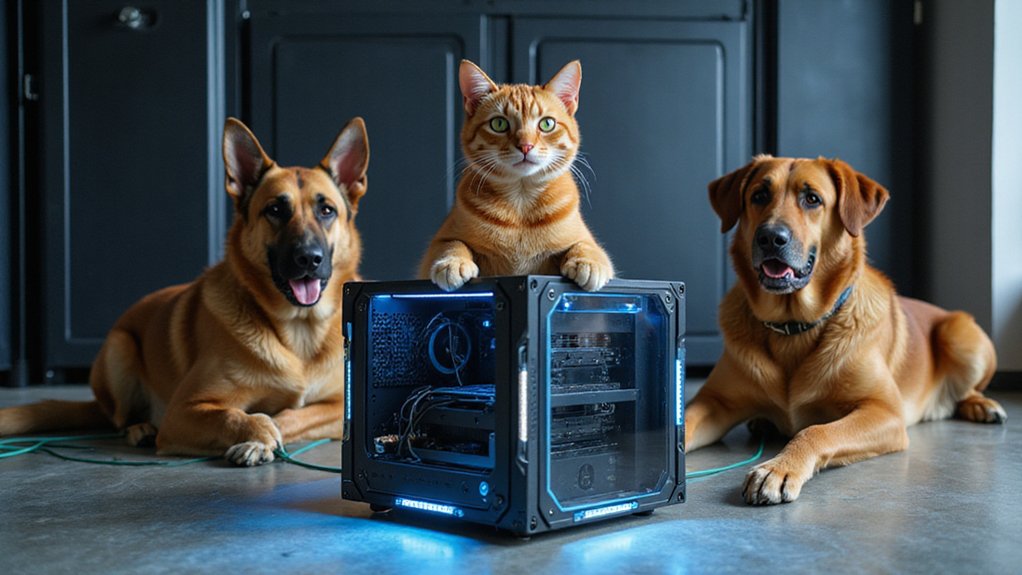MEW (MyEtherWallet) isn’t a cryptocurrency but rather a non-custodial Ethereum wallet that operates on a strikingly radical premise—users actually control their own money. This open-source interface supports ETH, ERC-20 tokens, and DeFi protocols while maintaining private keys exclusively on user devices through local encryption. With over 4 million monthly visitors, MEW proves that financial sovereignty doesn’t require trusting intermediaries with digital assets, though mastering this self-custody approach reveals additional complexities worth exploring.

The proliferation of cryptocurrency wallets has created a peculiar paradox where users seeking financial sovereignty must first navigate an increasingly complex maze of custodial arrangements.
This is an irony that MyEtherWallet (MEW) attempts to resolve by returning control directly to the individual.
MEW operates as an open-source, client-side interface that eliminates the intermediary problem plaguing traditional crypto custody solutions.
MEW cuts through the custody middleman nonsense that transforms financial independence into a bureaucratic nightmare.
Unlike exchanges that hold users’ private keys (thereby maintaining actual control over funds), MEW guarantees that private keys remain exclusively with the user through local secure enclave storage and Keychain encryption.
This non-custodial approach means even MEW’s development team cannot access user funds.
It is a welcome departure from the “trust us with your money” model that pervades the industry.
The wallet supports Ethereum and the entire ecosystem of ERC-20, ERC-721, and ERC-1155 tokens, encompassing everything from stablecoins like USDT and USDC to meme tokens such as Shiba Inu.
The platform automatically recognizes tokens without requiring manual addition, while offering spam token filtering.
Because apparently the crypto world needed digital junk mail too.
Beyond basic storage functionality, MEW integrates extensive DeFi capabilities directly into its interface.
Users can stake Ethereum to earn up to 4.0% APR on 32 ETH holdings, participate in decentralized protocols, and interact with Web3 applications without leaving the wallet environment.
This consolidation addresses the fragmentation that typically requires users to juggle multiple platforms for different blockchain activities.
The wallet’s commitment to privacy extends beyond mere marketing speak.
MEW explicitly refuses to track or monetize user data, a stance that seems almost quaint in today’s surveillance capitalism landscape. The platform employs cookies and similar technologies to enhance user experience and analyze site usage patterns.
Multiple account support allows users to compartmentalize their holdings for enhanced privacy and organizational purposes.
Available as both web interface and mobile applications across iOS and Android, MEW democratizes access to Ethereum’s ecosystem while maintaining the security standards necessary for meaningful financial sovereignty. The wallet has maintained impressive user adoption with over 4 million monthly web visits, demonstrating sustained trust in its security-first approach.
The platform’s open-source nature provides transparency that proprietary alternatives cannot match, allowing community verification of code integrity.
In essence, MEW represents a return to cryptocurrency’s foundational principle: individuals controlling their own financial destiny without requiring permission from traditional gatekeepers. Many community-driven projects like Shiba Inu have thrived on this foundation, utilizing timelocked contracts and multisignature wallets to provide additional investor protection while maintaining decentralized governance.
Frequently Asked Questions
How Do I Buy MEW Cryptocurrency?
One cannot purchase MEW cryptocurrency because it doesn’t exist as a tradeable asset.
MEW represents MyEtherWallet, a non-custodial interface for managing Ethereum-based holdings.
Instead, users create wallets through MEW’s platform, then acquire ETH or ERC-20 tokens via exchanges like Coinbase or Binance, subsequently transferring these assets to their MEW-generated addresses.
The platform itself remains free—though one wonders if users grasp this distinction before frantically searching for “MEW tokens” on trading platforms.
What Exchanges List MEW for Trading?
Major centralized exchanges like Bybit, Gate.io, MEXC, and KuCoin list MEW cryptocurrency for spot trading, while decentralized exchanges including Uniswap and SushiSwap facilitate swaps through liquidity pools.
The token’s availability spans multiple trading platforms, though liquidity varies considerably between venues.
Traders should note that MEW’s memecoin status means heightened volatility and potentially limited order book depth on smaller exchanges.
Is MEW Cryptocurrency a Good Investment?
MEW presents the classic meme coin conundrum: deflationary tokenomics and strategic airdrops suggest thoughtful design, yet anonymous founders and extreme volatility signal substantial risk.
While early adopters may capitalize on scarcity mechanics and Web3 gaming integration, prudent investors should recognize this as speculative entertainment rather than fundamental value creation.
The deflationary supply burns create artificial scarcity, but sustainable returns depend entirely on sustained community enthusiasm—historically unpredictable.
What Is the Current Price of MEW?
MEW currently trades at $0.003131, down from its mid-2024 peak of approximately $0.0041—a decline that illustrates the token’s characteristic volatility.
With $57.5 million in daily trading volume and a #162 CoinMarketCap ranking, the meme coin maintains respectable liquidity despite its price compression.
This represents roughly a 24% retreat from previous highs, though such fluctuations hardly surprise seasoned observers of the perpetually theatrical cryptocurrency markets.
How Do I Store MEW Tokens Safely?
MEW token storage follows standard ERC-20 security protocols, requiring hardware wallets like Ledger or Trezor for best protection.
Self-custody remains paramount—private keys must never touch online environments.
Cold storage through encrypted keystore files provides secondary security, though hardware solutions offer superior protection against the inevitable phishing attempts that plague meme token holders.
The irony? Securing cat-themed tokens requires the same institutional-grade practices as blue-chip cryptocurrencies.









